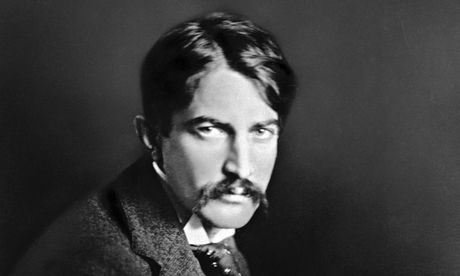
Stephen Crane, born in Newark, New Jersey in 1871, completed the short novel that would become the godfather of all American war novels, and an inspiration for writers as diverse as Ernest Hemingway and JD Salinger, while still in his early 20s. His subject, the war between the States, had actually ended before he was born, and he never experienced the horrors of battle. But the laconic realism of his prose, the fierce investigation of the soldier's psyche, and his impressionistic use of colour and detail convinced many readers that Crane was a veteran turned novelist.
Some critics see The Red Badge of Courage as a founding text in the modernist movement, a seminal novel whose influence haunts the composition of The Naked and the Dead, Catch-22, The Thin Red Line and Matterhorn, among others. Crane, a struggling freelance writer, researched his subject partly through magazine accounts of the civil war, a popular subject, and partly through conversations with veterans. He later said that he "had been unconsciously working the detail of the story out through most of his boyhood" and had imagined "war stories ever since he was out of knickerbockers". The idea of a writer immersing himself in the literary expression of his subject to make a book for publication, so familiar today, was new in the 1890s, as was his chosen genre, the war story. At this point he had published, unsuccessfully, at his own expense, just one novel, Maggie: A Girl of the Streets (1893), and was creatively out of sorts.
The Red Badge of Courage is not a conventional historical novel. Its texture is cinematic; at the same time, breaking the rules, it eschews all reference to time and place. As the "retiring fog" lifts on the opening page, an army is revealed "stretched out on the hills, resting". This is followed by a brilliant passage, surely an inspiration to subsequent generations of screenwriters: "At night, when the stream had become of a sorrowful blackness, one could see across it the red, eye-like gleam of hostile camp fires set in the low brows of distant hills."
Having set the scene, and expanded it with swift economy in a sequence of short chapters, Crane unfolds his creative purpose: to get under the skin of a young soldier, the volunteer Henry Fleming, who has enlisted as a challenge to himself. When fighting breaks out around him, Fleming's courage deserts him. He cannot face the possibility of suffering "a red badge", and flees, before later returning. More manoeuvres and skirmishes follow. Slowly, Fleming overcomes his fear, comes of age, learns to be a soldier and acquires an appetite for battle.
By the end, he has been "an animal blistered and sweating in the heat and pain of war", but he has come through, unscathed, and somehow made whole. "He turned now," Crane concludes, "with a lover's thirst to images of tranquil skies, fresh meadows, cool brooks – an existence of soft and eternal peace."
Possibly this was Crane's own wish-fulfilment. He was already fatally ill with tuberculosis. When this, his second novel, was published, he enjoyed a very brief moment of acclaim, while affecting to disdain his efforts. "I don't think The Red Badge to be any great shakes," he said. Crane died in Germany in 1900. After the first world war the novel was rediscovered, and has never been out of print since.
A note on the text
Crane began writing the book that would become The Red Badge of Courage (at first it was titled "Private Fleming/His various battles") in June 1893, and submitted the completed manuscript of 55,000 words to the publisher SS McClure, who held it for six months without making a decision. Once Crane had retrieved his still unpublished work he gave it to another publisher, Irving Bacheller, who sold the serial rights to the Philadelphia Press. So The Red Badge of Courage made its first appearance as a serialisation of just 18,000 words, a version that was quickly reprinted in more than 200 city newspapers and nearly 600 weekly publications, where it was an immediate hit with readers.
The success of the serialisation led to publication in book form by D Appleton in October 1895. This version was 5,000 words shorter than Crane's original; many strange and disfiguring cuts were not restored until the definitive Norton & Co edition of 1982. Here in the UK, William Heinemann launched a British edition in 1896 as part of its Pioneer series. HG Wells, who was a friend of Crane's, noted enviously that The Red Badge of Courage was welcomed with "an orgy of praise" in England, which encouraged Crane to settle here in the years before his premature death in 1900. It was a brief moment of happiness for the young man. Crane wrote to a friend: "I have only one pride and that is that the English edition of The Red Badge of Courage has been received with great praise by the English reviewers. I am proud of this simply because the remoter people would seem more just and harder to win." Another critic, Harold Frederic, wrote that: "If there were in existence any books of a similar character, one could start confidently by saying that it was the best of its kind. But it has no fellows. It is a book outside of all classification. So unlike anything else is it that the temptation rises to deny that it is a book at all."
Three more from Stephen Crane
Maggie: A Girl of the Streets (1893); The Open Boat and Other Tales of Adventure (1898); Active Service (1899).

